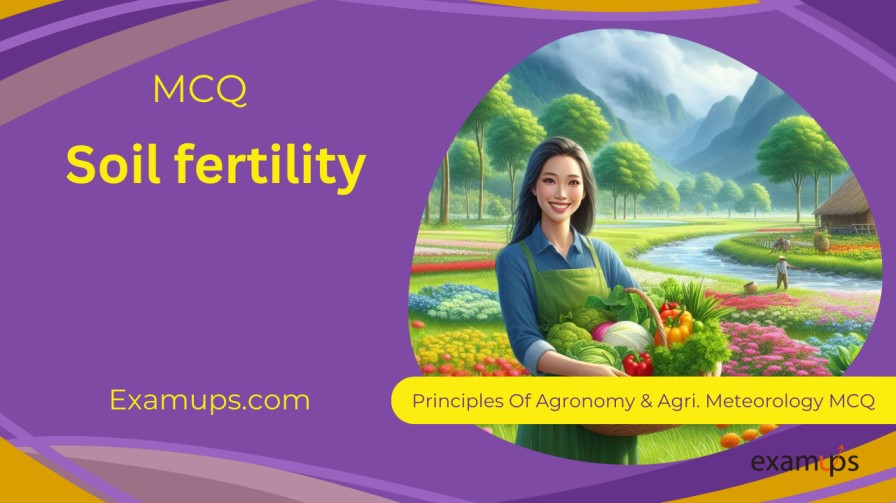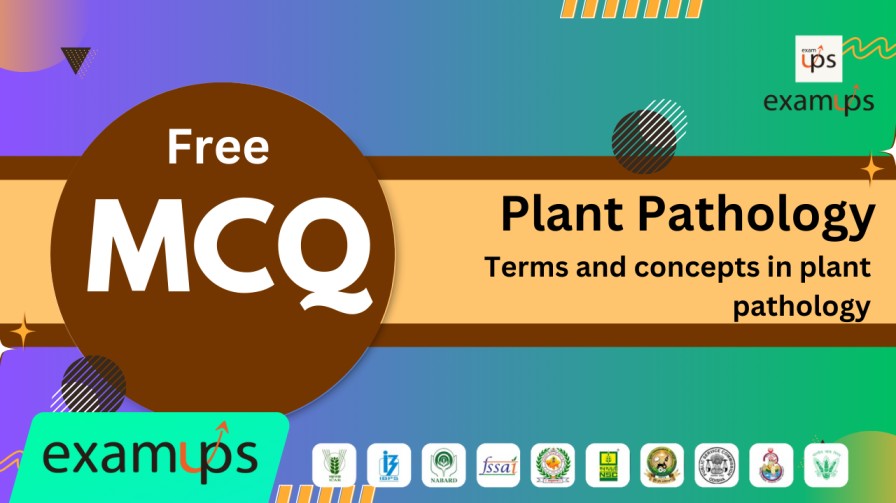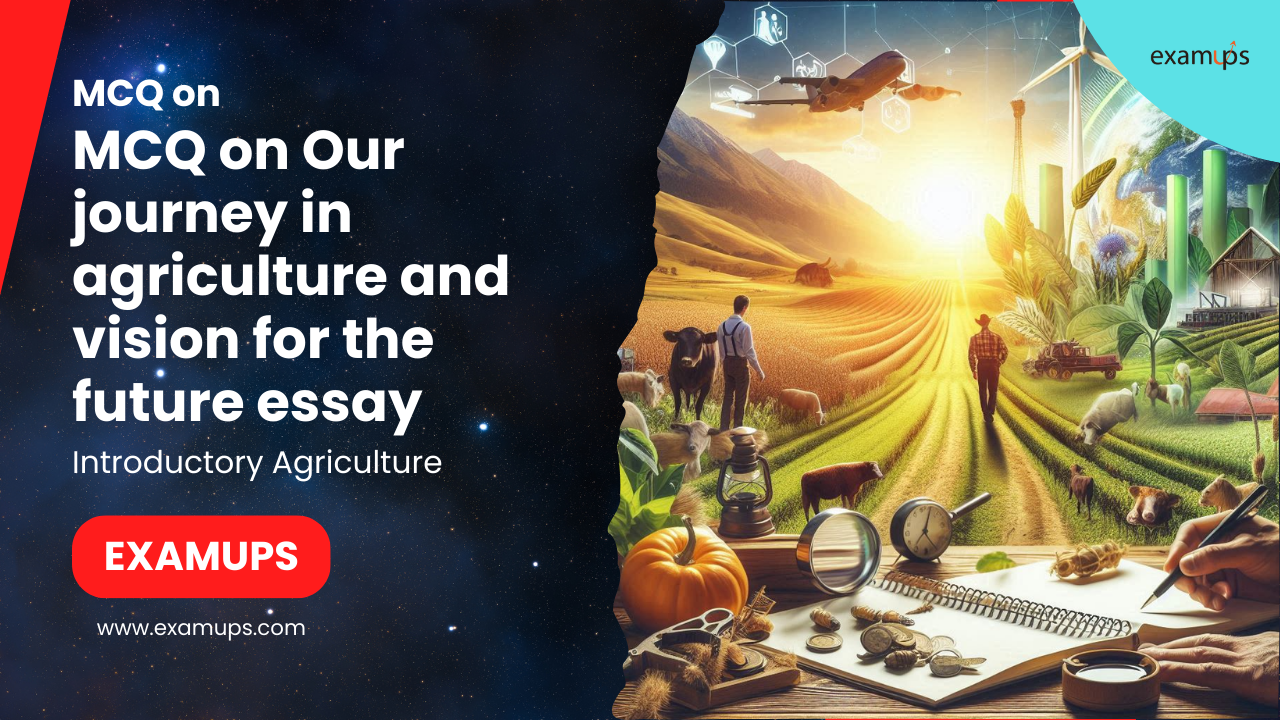MCQs on Soil fertility like ICAR-JEF, ICAR-SRF, ICAR-NET, IBPS-AFO/SO, Pre-PG, BHU Pre-PG, IFFCO-AGT, CCI, FCI, B.sc, M.sc, etc.
Question 1:
What is the term for the inherent capacity of the soil to supply plant nutrients in adequate quantities and suitable proportions?
- A) Soil productivity
- B) Soil fertility
- C) Soil structure
- D) Soil texture
Answer:
B) Soil fertility
Explanation:
Soil fertility refers to the inherent capacity of the soil to supply plant nutrients in adequate quantities and suitable proportions to support plant growth.
Question 2:
What does soil productivity refer to?
- A) The capacity of a soil to produce crops
- B) The number of microorganisms in the soil
- C) The ability of the soil to retain moisture
- D) The nutrient content of the soil
Answer:
A) The capacity of a soil to produce crops
Explanation:
Soil productivity is the capacity of a soil to produce crops. It is influenced by soil fertility and other factors like soil structure, moisture, and microbial activity.
Question 3:
Which of the following factors does NOT influence soil productivity?
- A) Soil moisture
- B) Soil microorganisms
- C) Soil erosion
- D) Soil color
Answer:
D) Soil color
Explanation:
Soil productivity is influenced by factors like soil fertility, physical condition, soil microorganisms, and moisture. Soil color does not have a direct impact on productivity.
Question 4:
Which type of nutrient loss is more prevalent in sandy soils?
- A) Erosion
- B) Leaching
- C) Gaseous loss
- D) Removal by crops
Answer:
B) Leaching
Explanation:
Leaching is more prevalent in sandy soils because of their low water-holding capacity, causing nutrients to be washed away from the soil.
Question 5:
How can nutrients be lost from the soil through denitrification?
- A) As a result of leaching
- B) Due to the removal by crops
- C) Due to soil erosion
- D) In gaseous form
Answer:
D) In gaseous form
Explanation:
Denitrification is a process where soil bacteria convert nitrates into nitrogen gas (N₂) or nitrous oxide (N₂O), leading to nitrogen loss in gaseous form.
Question 6:
Which of the following practices can help maintain soil fertility?
- A) Regular addition of plant nutrients
- B) Allowing soil erosion
- C) Removing crop residues from the field
- D) Using highly saline irrigation water
Answer:
A) Regular addition of plant nutrients
Explanation:
Regular addition of plant nutrients helps maintain soil fertility by replenishing nutrients lost due to crop uptake, leaching, or other factors.
Question 7:
Which crop removes the most potassium (K) from the soil?
- A) Rice
- B) Wheat
- C) Sorghum
- D) Maize
Answer:
C) Sorghum
Explanation:
Sorghum removes 200-300 kg/ha of potassium, which is the highest among the listed crops.
Question 8:
What is one method to prevent soil erosion, a common cause of fertility loss?
- A) Crop rotation
- B) Removing all vegetation from the soil surface
- C) Using heavy machinery on wet soils
- D) Plowing the soil in the opposite direction of the slope
Answer:
A) Crop rotation
Explanation:
Crop rotation helps maintain soil structure and reduces soil erosion by providing continuous vegetation cover, minimizing wind and water erosion risks.
Question 9:
Why is soil organic matter important for maintaining soil fertility?
- A) It helps bind soil particles together
- B) It increases soil salinity
- C) It prevents moisture retention
- D) It is composed entirely of plant nutrients
Answer:
A) It helps bind soil particles together
Explanation:
Soil organic matter improves soil structure by binding soil particles, enhancing moisture retention, and providing nutrients through decomposition.
Question 10:
Which of the following could be an inhibitory factor affecting soil productivity?
- A) Proper drainage
- B) Alkalinity
- C) Adequate soil moisture
- D) High organic matter content
Answer:
B) Alkalinity
Explanation:
Alkalinity can inhibit plant growth by affecting nutrient availability and soil structure, reducing soil productivity.
Question 11:
Which of the following is a broader term used to indicate yields of crops?
- A) Soil fertility
- B) Soil productivity
- C) Soil structure
- D) Soil organic matter
Answer:
B) Soil productivity
Explanation:
Soil productivity encompasses not only soil fertility but also other factors that influence crop yields, such as water supply, land slope, and climate.
Question 12:
Soil fertility can be analyzed in the laboratory. What other term is evaluated in the field under particular climatic conditions?
- A) Soil productivity
- B) Soil structure
- C) Soil salinity
- D) Soil texture
Answer:
A) Soil productivity
Explanation:
Soil productivity is influenced by field conditions and climate, while soil fertility is typically assessed in a laboratory for nutrient availability.
Question 13:
Which process converts nitrate (NO₃) to nitrogen gas (N₂)?
- A) Volatilization
- B) Denitrification
- C) Nitrification
- D) Fixation
Answer:
B) Denitrification
Explanation:
Denitrification is the process where nitrate (NO₃) is converted into nitrogen gas (N₂) by soil bacteria, resulting in nitrogen loss in gaseous form.
Question 14:
Which method helps maintain soil fertility through cultural practices?
- A) Adding lime to acidic soils
- B) Using fallow periods
- C) Adding inorganic fertilizers
- D) Applying bio-fertilizers like rhizobium
Answer:
B) Using fallow periods
Explanation:
Fallow periods allow the soil to rest and replenish nutrients, helping maintain soil fertility as part of cultural practices.
Question 15:
Which of the following is an organic material used to maintain soil fertility?
- A) Lime
- B) Gypsum
- C) Compost
- D) Ammonium nitrate
Answer:
C) Compost
Explanation:
Compost is organic material derived from decomposed plant and animal matter, used to improve soil fertility and structure.
Question 16:
Which of the following can be used as a soil amendment to improve soil structure and fertility?
- A) Paddy husk
- B) Inorganic fertilizers
- C) Bio-fertilizers
- D) Weedicides
Answer:
A) Paddy husk
Explanation:
Paddy husk can improve soil structure by adding organic matter and aiding in soil aeration and drainage, contributing to soil fertility.
Question 17:
Which type of fertilizer involves using microorganisms to enhance soil fertility?
- A) Inorganic fertilizers
- B) Bio-fertilizers
- C) Organic fertilizers
- D) Soil amendments
Answer:
B) Bio-fertilizers
Explanation:
Bio-fertilizers contain beneficial microorganisms like rhizobium, azotobacter, and blue-green algae, which enhance nutrient cycling and nitrogen fixation.
Question 18:
What is the potential status of soil in terms of nutrient availability?
- A) Soil productivity
- B) Soil fertility
- C) Soil structure
- D) Soil amendments
Answer:
B) Soil fertility
Explanation:
Soil fertility refers to the potential status of the soil regarding its ability to supply plant nutrients in adequate quantities.
Question 19:
Which cultural practice involves growing different crops in the same field during different seasons to maintain soil fertility?
- A) Mixed cropping
- B) Fallowing
- C) Crop rotation
- D) Green manuring
Answer:
C) Crop rotation
Explanation:
Crop rotation involves growing different crops in the same field in a systematic sequence, allowing the soil to regenerate and maintain fertility.
Question 20:
Which of the following represents the interaction of all factors that determine the magnitude of crop yields?
- A) Soil productivity
- B) Soil fertility
- C) Soil amendments
- D) Soil structure
Answer:
A) Soil productivity
Explanation:
Soil productivity refers to the interaction of various factors, such as soil fertility, water supply, and land slope, that ultimately determine crop yields.










